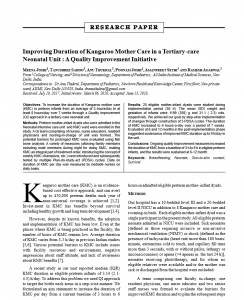
Kangaroo mother care (KMC) is an evidence-based cost effective approach, and can avert up to 450,000 preterm deaths each year if near-universal coverage is achieved. Invest-ment in KMC has benefits beyond survival including healthy growth and long term development.
However, despite its known benefits, the adoption and implementation of KMC has been low. Even at the places where KMC is being practiced in the facility, the number of hours of KMC remain low. Average duration of KMC varies from 3-5 h/day in previous Indian studies. Various potential barriers to KMC include issues with facility resources and environment, negative impressions about staff attitude, and lack of awareness about KMC benefits.
A recent study in our unit reported median (IQR) KMC duration in eligible preterm infants of 3.14 (2.14.3) h/day. To address this problem we used QI approach to target the bottle neck areas in a step-wise manner. We formulated an aim statement to increase the duration of KMC per day from a current baseline of 3 hours to 6 hours in admitted eligible preterm mother- infant dyads.
—
This special issue of Indian Pediatrics (September 2018; Volume 55: Number 9) highlights mechanisms that can support health care providers in using various quality improvement (QI) approaches and showcases some of the improvement projects undertaken in India by different teams.
The USAID ASSIST Project started working in India in September 2013; initially working directly with districts and facilities to help them learn how to use QI approaches to save lives. This work went well and the staff in these facilities were able to reduce perinatal mortality by 15% over 18 months. During this time, we met great partners from important organizations and institutions across India.
These institutions are now leading a growing movement to help more people apply QI methods to deliver care that prevents harm, improves outcomes, and meets the needs of the people receiving it through their own networks using domestic funding; continuing these lifesaving efforts after ASSIST technical support has ended.
The supplement shows important results of the ongoing QI work in these networks and shows how domestic QI networks, earlier supported by ASSIST, are now independently supporting and spreading the use of QI methods to provide better care.